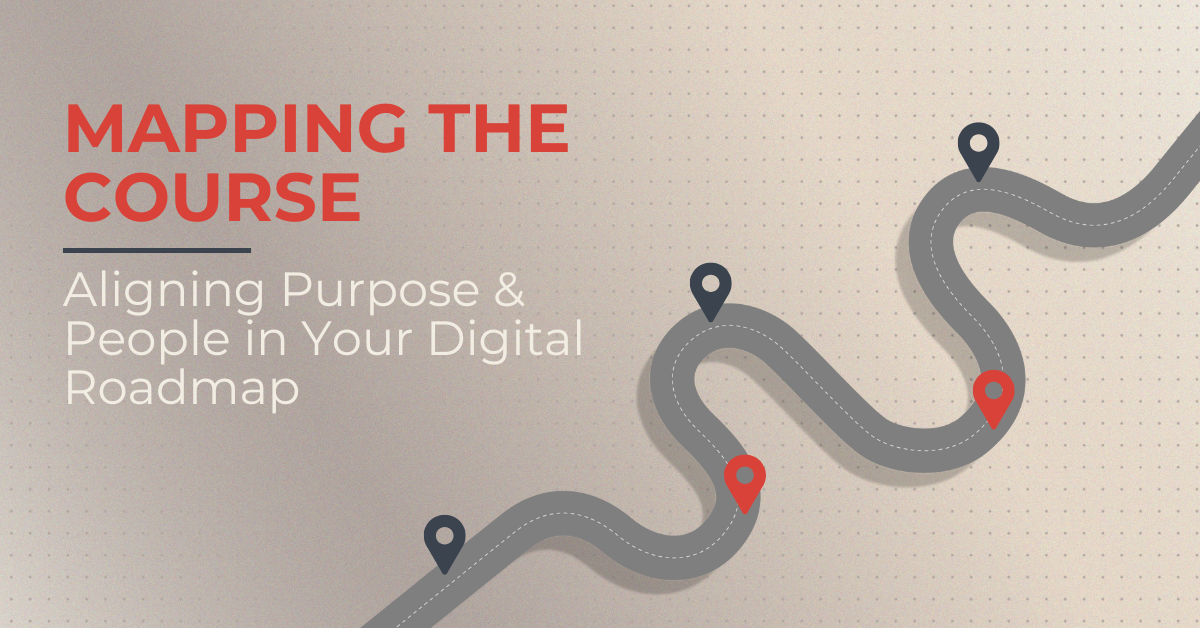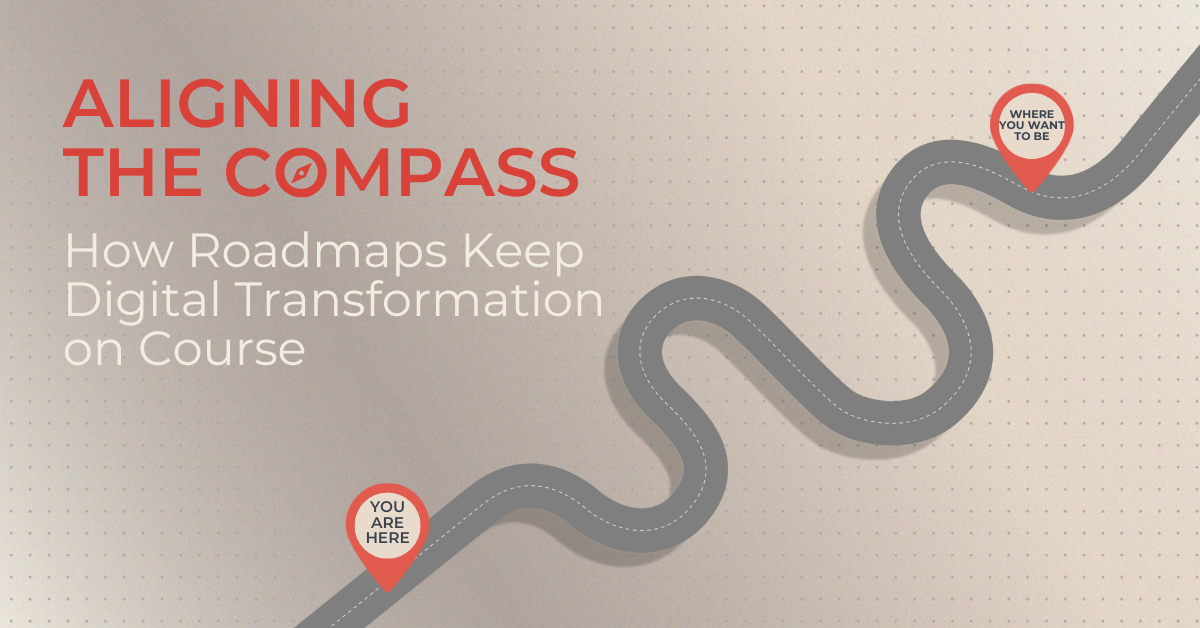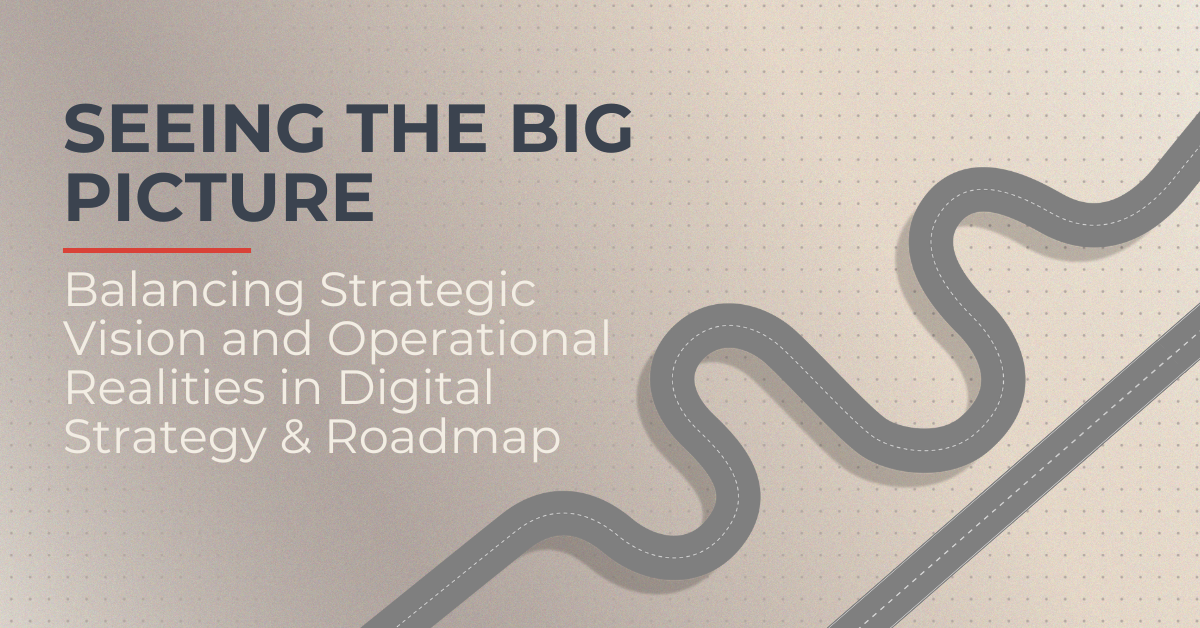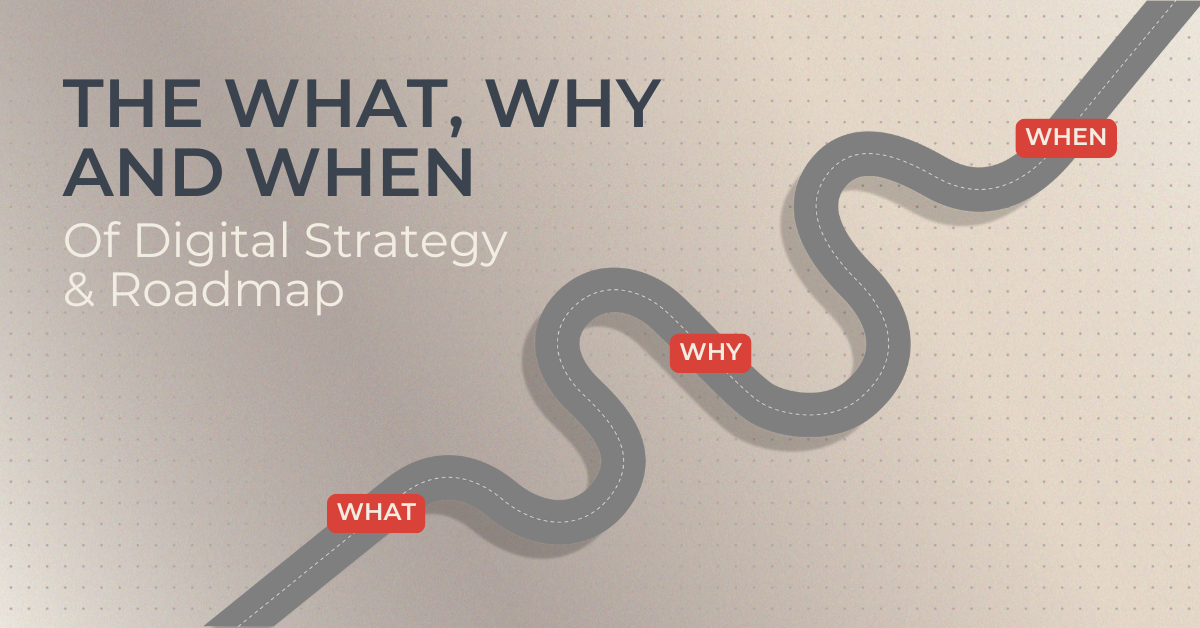
Whitney White
Whitney is a Certified Management Consultant (CMC) and the Principal Consultant of the Digital Advisory Services practice. With over 15 years of professional experience, she brings a cross-functional lens to digital transformation, grounded in expertise across project management, business analysis, process improvement, and data-driven decision making. Her work spans both public and private sectors, where she is known for navigating complexity with clarity, fostering alignment across stakeholders, and helping organizations turn strategic intent into actionable, measurable outcomes. Whitney is passionate about people, systems, and solving the right problems — and thrives at the intersection of data, process, and purpose. Whether shaping digital strategy or designing roadmaps for change, she brings thoughtful structure, insight, and a collaborative spirit to every engagement.
A successful digital roadmap doesn’t start with technology—it starts with clarity.
Clarity about who should be involved, and why the work matters. In this final post of our Digital Strategy & Roadmap series, we explore two essential elements that shape every successful plan: engaging the right stakeholders and defining the strategic intent behind your initiatives.
When these two elements are aligned, your roadmap becomes more than a sequence of projects—it becomes a shared path forward, grounded in purpose and built with the insight of those who will bring it to life.
Learn more about Strategy & Roadmap
The Stakeholder Spectrum - The 'Who' of Digital Strategy & Roadmap Development
When it comes to developing a digital strategy and roadmap, the question isn’t just about what to do or how to do it, it’s also about who needs to be involved. A successful strategy is not created in isolation; it’s the product of collaboration, alignment, and input from a diverse spectrum of stakeholders. Without the right voices at the table, even the most well-intentioned roadmaps can fall short.
Every phase of strategy and roadmap creation benefits from the insights, oversight, and expertise of a diverse set of stakeholders, each playing a distinct role in shaping the journey.
We call this the Stakeholder Spectrum, and it’s the foundation for ensuring your roadmap reflects both strategic priorities and operational realities. Let’s explore who these stakeholders are, how they contribute, and where their input matters most.
The Stakeholder Spectrum
In our approach to digital strategy and roadmap development, we recognize several key stakeholder groups within client organizations. Each group brings unique perspectives and plays a critical role in shaping, validating, and executing the roadmap.
The Stakeholder Spectrum is represented in the visual below, highlighting five key groups involved in digital strategy and roadmap development. Each layer represents a stakeholder group, starting with Sponsorship at the core and radiating outward to Customer Working Groups, showcasing how their contributions align with understanding where we are today, defining where we want to be, and planning how we’ll get there.

Sponsorship (Core Layer)
At the center is Sponsorship, the group or individual responsible for setting the organization’s vision and strategic direction. Sponsors are pivotal in defining where we want to be, ensuring the digital strategy aligns with overarching business goals. They secure resources and provide the mandate for change, enabling the organization to chart a course for how it will get there. While they may not focus deeply on the current state, they rely on inputs from other stakeholders to ensure that the roadmap is realistic and achievable.
Governance Teams
Surrounding the core are the Governance Teams, who oversee alignment and prioritization. Their role spans all three pillars: they validate the organization's understanding of where we are today, ensuring operational realities are accounted for; they align initiatives with where we want to be, resolving conflicting priorities; and they oversee the development of the roadmap, defining how we’ll get there through sequenced, prioritized initiatives.
Governance teams hold the critical responsibility of ensuring that the roadmap reflects the organization’s broader objectives, even when it requires making hard decisions. This could mean resolving conflicting priorities, pruning ideas that don’t align with the strategic vision, or dictating a clearer path forward when consensus proves challenging. However, this isn’t a top-down, rigid process. Effective governance thrives on collaboration—leveraging input from all stakeholder groups to ensure that decisions are informed, balanced, and focused on delivering the most value.
By balancing collaboration with decisive action, governance teams play a pivotal role in ensuring that the roadmap remains actionable and aligned with the organization’s goals, while fostering a sense of ownership across all levels of the organization.
Tactical Working Groups
The Tactical Working Groups bring practical, hands-on insights to the process, focusing on the bridge between strategy and day-to-day operations. Their role is crucial in establishing where we are today, as they can identify gaps, inefficiencies, and bottlenecks that impact the organization's ability to execute effectively. Tactical groups ensure that the roadmap reflects realistic and achievable initiatives while maintaining alignment with the organization’s broader goals.
By contributing their knowledge of processes and workflows, tactical working groups also play a role in shaping how we’ll get there, helping to validate the feasibility of proposed initiatives and ensuring that implementation plans are grounded in reality. Their insights complement those of subject matter experts, adding a layer of practicality to the overall strategy.
Subject Matter Experts (SMEs)
The Subject Matter Experts (SMEs) bring deep technical and process-specific knowledge to the roadmap development process. While tactical working groups focus on the broader feasibility of initiatives, SMEs dive into the details—examining specific systems, tools, and workflows to identify opportunities for improvement. Their expertise is critical in establishing where we are today, as they can pinpoint precise gaps and inefficiencies within their domain.
SMEs also play a pivotal role in defining where we want to be, contributing insights into what is possible and ensuring that the future state reflects realistic advancements in technology, processes, or capabilities. When it comes to how we’ll get there, SMEs provide the technical and process-level guidance needed to design initiatives that are both achievable and impactful.
While tactical groups ensure that initiatives are practical at an organizational level, SMEs ensure that solutions are feasible and optimized within their specific areas of expertise. Together, these groups provide complementary perspectives that balance strategic goals with real-world implementation.
Customer Working Groups (Outer Layer)
The Customer Working Groups serve as the voice of the end-users. Their primary contribution is to ensure that the digital strategy and roadmap reflect the needs, pain points, and expectations of those who will ultimately experience the outcomes of the transformation. They provide crucial insights into where we are today, offering perspectives on how current processes, tools, or services impact user satisfaction and productivity.
In defining where we want to be, customer working groups contribute feedback that aligns the organization’s future vision with real-world demands. For example, they might highlight the need for more seamless digital experiences, faster self-service tools, or greater accessibility to systems—ensuring that the roadmap addresses not only operational goals but also the broader user experience.
When it comes to how we’ll get there, customer working groups validate the feasibility and relevance of proposed initiatives from a user perspective. Their input ensures that the roadmap not only aligns with strategic priorities but also delivers meaningful and measurable value to the people it serves.
Unlike other groups, the customer working group’s focus is outward facing, ensuring the roadmap accounts for external realities such as market trends, competitive pressures, and customer expectations. Their contributions balance the internal operational focus of other stakeholders, adding depth and alignment to the overall strategy.
Setting the Stage for Strategic Direction
The success of your digital strategy and roadmap depends on engaging the right stakeholders at the right time. The Stakeholder Spectrum ensures that every phase of the process—understanding where we are today, defining where we want to be, and planning how we’ll get there—is informed by the perspectives, expertise, and priorities of the people who shape and experience the transformation.
When sponsors provide the vision, governance teams maintain alignment, tactical groups ground the strategy in reality, SMEs refine the details, and customers validate the outcomes, the result is a roadmap that is collaborative, actionable, and aligned. Together, these stakeholders bring the diversity of thought and depth of insight required to navigate the complexities of transformation.
Ask yourself:
- Are your stakeholders aligned on the current state and future goals?
- Have you engaged the right voices to represent both internal and external realities?
- Is your roadmap reflective of a balanced, inclusive, and actionable process?
Engaging your Stakeholder Spectrum is not just about inclusion—it’s about creating clarity, focus, and momentum to turn strategy into success.
Strategic Intent - Defining the 'Why' and Setting the Direction for Your Digital Roadmap
With the right stakeholders engaged, the next step is defining a clear purpose—your strategic intent. Before you can decide what initiatives to prioritize or how to approach them, you must first answer the most fundamental question: Why are we doing this? Your organization’s strategic intent sets the direction for the entire journey, aligning stakeholders and ensuring every action contributes to your goals. It connects your organizational objectives to actionable digital initiatives, ensuring your efforts are not only aligned but also impactful.
Defining the 'Why': The Core of Strategic Intent
Before you can define your organization’s "why," you need a clear understanding of the context in which you operate. Organizational goals provide the foundation—they define where the organization wants to go. But to determine how technology will enable those goals, you need situational awareness. This means understanding your internal capabilities, external pressures, market trends, and customer expectations. For example:
- Internal Perspective: Are your current systems and processes equipped to handle your growth targets?
- External Perspective: Are there emerging technologies, competitive pressures, or customer demands that need to be addressed?
This situational awareness serves as a reality check, helping you answer the key question: How will digital transformation help us achieve our organizational goals? It ensures that your "why" isn’t just aspirational but grounded in the organization’s unique context.
Once you have this clarity, the "why" can be articulated as a series of Digital Change Goals that connect organizational objectives with actionable priorities.
Defining the "why" also enables you to measure success. By identifying metrics tied to your goals (e.g., customer retention rates or improved engagement scores), you create a framework for tracking progress and ensuring accountability.
And perhaps most importantly, when your "why" is clear, you can more easily recognize the "why nots." Initiatives that don’t align with your strategic intent become easier to identify and set aside, helping your organization stay focused on what truly matters.
.png?width=1920&height=1080&name=Blog%20Images%20(1).png)
Cascading Goals: Translating Vision into Digital Change
With the "why" defined, the next step in the Strategic Intent Phase is to cascade high-level organizational goals into actionable Digital Change Goals. This cascading process ensures that the roadmap not only aligns with strategic priorities but also provides clear direction for execution.
The cascade begins with your organizational goals, which articulate where you want to be. From these goals, Digital Change Goals are derived, focusing on how technology will enable the achievement of those objectives. These Digital Change Goals not only specify what needs to be done but also begin to hint at how success will be measured.
For example:
- Organizational Goal: Enhance customer satisfaction to drive retention.
- Digital Change Goal: Develop a seamless omnichannel customer experience by integrating digital touchpoints.
To make these goals actionable, it’s important to think about measures of success early. For instance:
- How will you know customer satisfaction is improving?
- What metrics will indicate the success of your omnichannel strategy?
While measures are explored in more depth later in the process, introducing them during the Strategic Intent Phase provides clarity and alignment. These metrics act as guideposts, ensuring that every initiative in the roadmap is tied to an outcome that can be tracked and evaluated.
By cascading goals in this way, organizations create a roadmap that is not only aligned with strategic priorities but also focused on delivering measurable value. Measures provide the "north star" for your initiatives, helping to maintain focus and momentum throughout the transformation journey.
Collaborative Alignment: The Role of Stakeholders
The Strategic Intent Phase isn’t just about defining goals—it’s about ensuring alignment across the organization. This phase thrives on the principle of collaborative co-creation, where the strategy is shaped not by a single voice but through the collective expertise and perspectives of diverse stakeholder groups. Each stakeholder plays a critical role in answering key questions: What will be different as a result of this strategy? and How will we know when we’ve succeeded?
In this phase, the collaborative effort draws from the Stakeholder Spectrum. Sponsors, governance teams, tactical working groups, and even subject matter experts work together to shape a vision that is not only aligned but also actionable.
Through this collaborative co-creation process, stakeholders don’t just contribute—they align on a shared vision of success. This alignment is essential for defining Digital Change Goals and setting clear outcomes. These outcomes form the basis for answering the questions: What will be different as a result of these initiatives? and How will we measure success?
Collaborative alignment also ensures that the strategy reflects the organization’s unique context. It balances high-level objectives with operational realities, creating a foundation for a roadmap that is ambitious yet achievable. By bringing together the right stakeholders at the right time, this phase ensures that the strategic intent is not only clear but also collectively owned—an essential ingredient for successful execution.
Right-Sizing Your Strategic Intent
When defining strategic goals, it’s important to strike the right balance. While it’s tempting to address every need and opportunity, setting too many goals can dilute focus and overwhelm teams during execution. The strategic intent should encompass a cross-section of high-level goals that represent the organization’s priorities without becoming unmanageable.
Similarly, metrics should be meaningful but not excessive. A smaller set of well-defined measures is easier to implement, track, and evaluate, ensuring that progress can be assessed without creating unnecessary complexity. By right-sizing your strategic intent, you cast a wide enough net to be representative but maintain focus and clarity for effective implementation.
The Journey Forward
The Strategic Intent Phase lays the foundation for your digital transformation journey. By defining your "why," cascading goals, fostering alignment, and right-sizing your approach, you create a roadmap that is clear, actionable, and purpose-driven.
This concludes our four-part series on Digital Strategy & Roadmaps. Whether you're just starting your planning process or refining an existing roadmap, the path forward hinges on clear intent, the right voices at the table, and a plan built for execution.
If you're ready to put your strategy into action—or if you'd like support defining your “what,” “who,” and “why”—we’re here to help. Contact us to start the conversation.
Missed the last installment of Whitney's Digital Strategy & Roadmap blog series? Check out "Seeing the Big Picture: Balancing Strategic Vision and Operational Realities in Digital Strategy & Roadmap".
If you're ready to take the next step and need expert guidance, let’s discuss how we can partner with you to develop a digital strategy and roadmap that aligns with your goals, optimizes your resources, and drives meaningful transformation. Reach out today to start the conversation.
About the Author

Whitney White
Whitney is a Certified Management Consultant (CMC) and the Principal Consultant of the Digital Advisory Services practice. With over 15 years of professional experience, she brings a cross-functional lens to digital transformation, grounded in expertise across project management, business analysis, process improvement, and data-driven decision making.





Submit a Comment